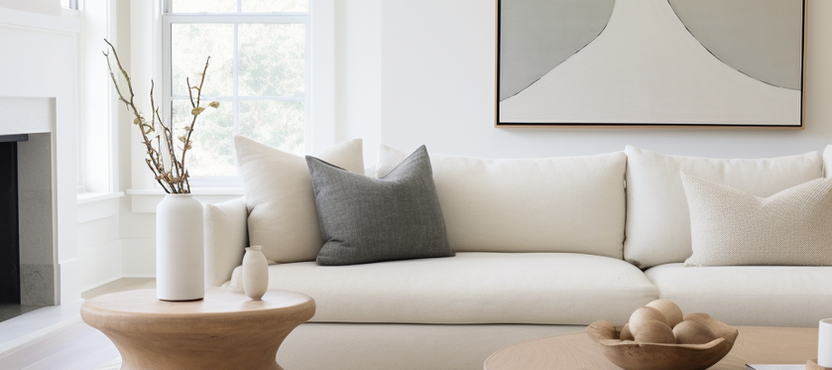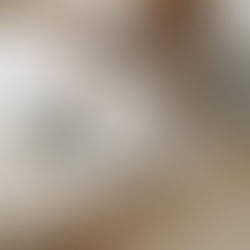Graphite vs Charcoal: A Designer’s Breakdown of the Dark Tones People Always Get Wrong
- Beril Yilmaz

- 2 hours ago
- 6 min read
Choosing between graphite vs charcoal sounds simple until you actually hold the samples up to the wall. Suddenly one looks unexpectedly blue, the other strangely dense, and neither behaves the way the little rectangle promised. This is exactly where most homeowners start second-guessing themselves, especially when working with dark tones that demand precision.
In interior design, graphite and charcoal aren’t just “dark colours.” They’re two completely different personalities. One behaves sharper and more sculptural, the other reads deeper and more grounded depending on light, scale and surrounding materials. People often think they can use them interchangeably, but that’s usually where the design mistakes begin.
In this blog, we’ll walk through exactly how graphite vs charcoal differ, how each shade behaves in natural and artificial light, and—most importantly—when to choose one over the other. By the end, you’ll be able to read these two tones confidently, the same way designers do.
At A Glance
Graphite vs charcoal undertones
How each colour behaves in different lighting
When graphite works better than charcoal
When charcoal outperforms graphite
Material pairings that influence both tones
Designer-approved examples and applications
Mistakes to avoid when choosing between graphite vs charcoal
1. Graphite vs Charcoal: Understanding Their Core Colour DNA

Graphite and charcoal might sit on the same end of the colour spectrum, but their foundations couldn’t be more different. Graphite usually carries a subtle steel-like undertone—sometimes a hint of blue, sometimes a muted mineral grey. Charcoal leans noticeably darker, thicker, and more saturated, often with deeper neutral bases that give it a heavier presence in a room.
This is why graphite feels more architectural and crisp, while charcoal reads earthier and more substantial. Neither is better or worse. They simply perform in very different ways once they’re on your walls, furniture or joinery.
Designer Tip: Hold both swatches against natural daylight first. Graphite often reveals a cooler cast while charcoal sits deeper with fewer undertone surprises.
YOU MAY LIKE
2. Graphite vs Charcoal: How They React to Natural Light

This is the moment where most people misinterpret these colours. Graphite tends to brighten slightly as daylight moves across it. It’s still dark, but its reflective quality makes it shift between an iron-grey and a cooler, sharper tone. In south-facing rooms, this can look sleek and intentional.
Charcoal absorbs light instead of reflecting it. The tone deepens, strengthens and settles into the space rather than shifting. In sun-drenched rooms, charcoal can feel beautifully grounded and solid rather than washed out or diluted.
Designer Tip: Use graphite when you want movement and definition; use charcoal when you want consistency regardless of changing daylight.
3. Graphite vs Charcoal: How They React to Artificial Light

When artificial lighting enters the scene, graphite tends to reveal its cooler side—especially under LEDs. That crisp edge becomes more pronounced, which can be exactly what you want in more modern or sharp-edged interiors. However, it can also look unexpectedly blue if the bulb temperature isn’t chosen carefully.
Charcoal—because of its heavier base—remains steady and predictable under artificial light. It doesn’t suddenly lean cool or look overly saturated. It stays balanced, which is why designers often choose charcoal for larger surfaces like media walls, wardrobes and feature joinery.
Designer Tip: If you’re using graphite indoors with LEDs, choose bulbs around 3000K to avoid unwanted coolness creeping in.
Want Help Choosing the Right Shade for Your Project?
If you’re comparing graphite vs charcoal and feel unsure which direction to take, we can guide you through it. Colour decisions become much easier when we analyse your space’s light, materials and layout together. You can book a design consultation today and we’ll walk through the perfect palette for your project.
4. Graphite vs Charcoal: When Graphite Works Better

Graphite is your best friend when you want definition without overwhelming the space. It works brilliantly in rooms with strong architectural lines—window trims, internal doors, built-in shelving, stair spindles, or modern profiles where crispness matters. Because of its clarity and reflective behaviour, it highlights edges rather than consuming them.
Graphite also performs well with cool stone, stainless steel, brushed nickel and greige flooring. These pairings make the colour feel intentional rather than accidental.
Designer Tip: Choose graphite if your room relies on clean lines or if you want the dark tone to outline features rather than sink into them.
5. Graphite vs Charcoal: When Charcoal is the Better Choice

Charcoal shines in spaces that need depth and grounding. If graphite feels too sharp or too reactive to lighting conditions, charcoal provides the stability you’re looking for. It’s ideal for media walls, fireplace surrounds, kitchen cabinetry and large joinery where a denser, more substantial tone creates balance.
Unlike graphite, charcoal doesn't shift dramatically throughout the day. That steadiness is why it’s often the go-to for larger surfaces or places where you want the dark tone to feel integrated into the architecture.
Designer Tip: Choose charcoal for built-ins, larger surfaces or when you want a dark tone that stays visually stable throughout the day.
6. Graphite vs Charcoal: Material Pairings That Change the Colour

Material pairing is the part people don’t consider enough. Graphite reacts strongly to neighbouring finishes. Place it next to marble with grey veining, and it highlights pattern beautifully. Position it next to cooler flooring or aluminium frames, and it looks even more precise.
Charcoal, on the other hand, anchors tactile materials. Timber with moderate grain, matte stone, textured plaster, and denser textiles all deepen charcoal’s presence, making it feel integrated and cohesive rather than heavy.
Designer Tip: Use graphite to enhance crisp materials; use charcoal to steady textured or weighty materials.
7. Graphite vs Charcoal: Where They Commonly Go Wrong

Most design mistakes happen when people assume graphite and charcoal are interchangeable. Graphite used on large surfaces can appear unexpectedly reactive, creating the sense that the colour is shifting all day long. Charcoal used on thin trims or mouldings can feel overly heavy or visually compressed.
Another common mistake is choosing a paint based solely on its name. “Graphite” from one brand might lean distinctly blue, while another brand’s version might be a crisp iron-grey. Similarly, “charcoal” shades differ widely in depth and neutrality.
Designer Tip: Always compare graphite vs charcoal against the flooring first—floors dictate how both colours behave more than anything else.
8. Graphite vs Charcoal: Which One Photographs Better?

If you love documenting your home, this small detail matters more than you’d think. Graphite tends to photograph lighter than expected, sometimes revealing undertones that aren’t noticeable in person. Camera sensors amplify its cooler elements.
Charcoal photographs darker, more controlled and more consistent. It delivers that strong, bold look in images without the risk of accidental colour shifts.
Designer Tip: For photography moments—shelving, feature walls, styling corners—charcoal tends to produce more predictable results on camera.
9. Graphite vs Charcoal: How to Test Them Properly

Testing graphite vs charcoal samples correctly will reveal everything before you commit. Use large boards rather than tiny swatches. Move them around the room at different times of day. Pay attention to how daylight and artificial light reshape the tone.
Graphite will shift more, so expect changes. Charcoal will stay more consistent. Neither reaction is a bad thing—as long as you’re expecting it.
Designer Tip: Test each shade next to your flooring, trims and the largest furniture item in the room to get the most accurate read.
10. Graphite vs Charcoal: When In Doubt, Use This Rule

A simple rule designers use: choose graphite when you need definition, and choose charcoal when you need weight. If your room feels flat, charcoal brings structure and presence. If your room feels heavy or dense, graphite introduces clarity without losing depth.
This one rule solves most indecision.
Designer Tip: If your architecture has curves, profiles or detailed joinery, start with graphite; if it has broad, flat planes, start with charcoal.
Conclusion
Graphite vs charcoal isn’t just a question of “which dark shade looks nicer.” It’s a strategic choice that determines how your room feels, reads and functions visually. Once you understand how each shade behaves in different lighting, how it interacts with materials, and where its strengths lie, the right decision becomes obvious.
Whether you’re designing a media wall, repainting internal doors or choosing cabinetry, these two tones offer very different results. Now that you know how designers make the call, you can approach the decision with clarity instead of hesitation.
FAQ: Graphite vs Charcoal
What is the main difference between graphite and charcoal?
Graphite is a cooler, more architectural shade with subtle reflectiveness, while charcoal is denser, deeper and more stable under different lighting conditions.
Is graphite or charcoal better for kitchen cabinets?
Charcoal is usually more predictable and balanced for large surfaces like cabinetry, while graphite can sometimes appear cooler or shift more in different lighting.
Does graphite look blue on walls?
It can lean cool or slightly blue under certain artificial lighting, which is why testing with your actual bulb temperature is important.
Is charcoal too dark for small rooms?
Not necessarily. Charcoal can ground a small room effectively because it stays visually stable and doesn’t shift throughout the day.
Start Your Colour Transformation With Us
If you’re ready to choose a tone that truly works for your space—whether graphite, charcoal or something in between—we can guide you every step of the way. Together, we’ll create a palette that strengthens your architecture, complements your materials and feels intentional from every angle. You can book a design consultation today to begin your project with us.
Author Bio
Beril Yilmaz is a UK-based interior designer known for creating thoughtful, detail-driven spaces that balance practicality with refined character. Her projects blend architecture, materials and colour in a way that feels deliberate and elevated, always focusing on clarity, proportion and purpose.



































